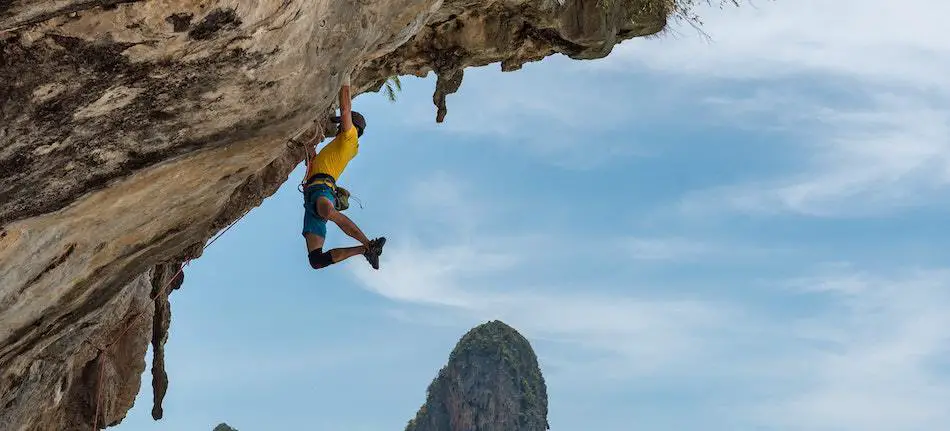
Rock climbing has exploded in popularity in recent years. One of the first questions that many people have when they see videos of people climbing cliffs and mountains is how those climbers don’t fall.
Climbers insert wedge-shaped pieces of metal, often called ‘protection’, into cracks in the rock. They then clip a rope through this ‘protection’ and tie themselves into that rope. If they fall, the protection jams into the crack and holds in place, anchoring the rope (and therefore, the climber) to the wall.
By clipping themselves into a piece of protection that’s secured to the wall, climbers ensure that they don’t fall all the way to the ground when they slip off the wall. This is what keeps them safe and allows them to climb without fear of dying. Climbers will carry this protection with them as they go up the route, placing it every ten to fifteen feet to ensure that they never fall too far.
To make more sense of this, check out this video of someone falling while climbing:
Sure, some of these falls are pretty painful, but you can see that the climber doesn’t hit the ground in any of them. Keep in mind that this is also a compilation of bad falls; most of the time, they’re a lot more gentle.
Although this is the most common method of protecting yourself while climbing, there are many ways that are used. In the rest of this article, I break down the different ways that climbers prevent themselves from falling while climbing!
All Climbers: A Belayer
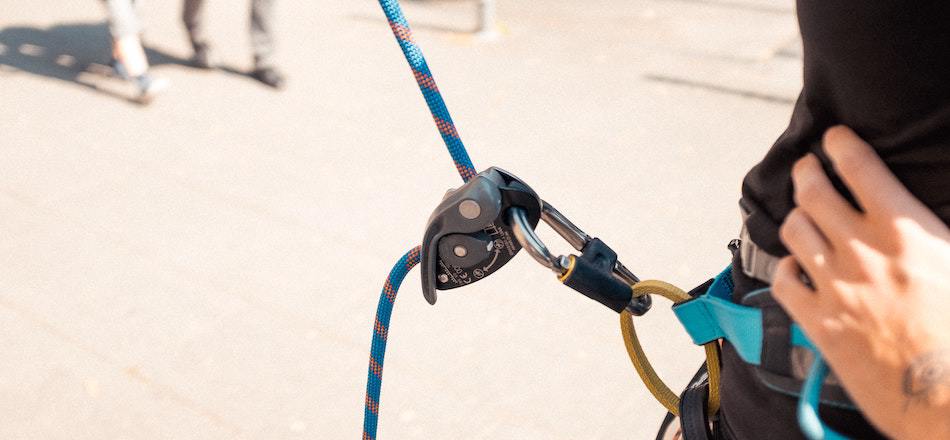
Really, a belayer is the most important thing that stops every climber from falling. The belayer is the person who clips themselves to the other side of the rope that the climber is on. They then feed the rope through a ‘belay device’, which essentially is a piece of metal that creates friction (as seen in the picture above).
When the climber falls, the rope pulls tight, and the belay devices cinches closed around it so that the rope can’t move through it anymore. The belayer then acts as a counterweight to the climber, weighing down the other end of the rope so they don’t hit the ground.
Every time you rock climb, you should have a belayer, because they quite literally have your life in their hands. However, there are other things that contribute to climber’s not falling, which I review below.
Sport Climbers: By Using Bolts
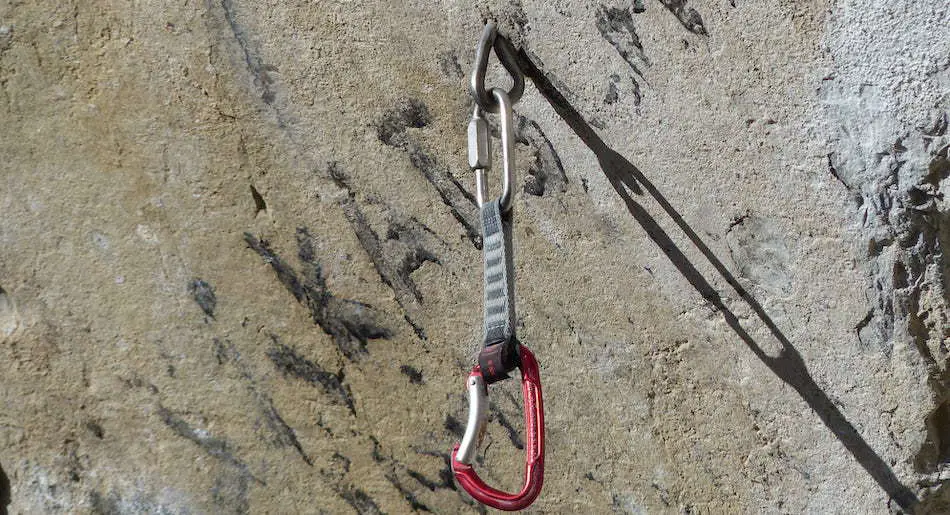
One distinction in rock climbing is that between ‘sport’ climbing, which uses bolts, and ‘trad’ climbing, which uses the protection I discussed above. Sport climbers have a different way of preventing themselves from falling.
Sport climbers use bolts that are drilled into the rock to prevent themselves from climbing. They clip a carabiner to the bolt and then slide their rope through this carabiner; if they fall, the rope pulls on the carabiner and stops them from hitting the ground.
Sport climbing, the most popular form of rock climbing, makes use of fixed bolts that are drilled or glued in place into the rock. As a climber goes up a route, they clip their rope through these bolts to ensure that they get caught if they fall.
The benefits of sport climbing are that it is much easier to learn, and safer, than trad climbing. However, there are also some downsides. Namely, you can only sport climb where someone has gone before you and drilled the bolts into the wall, so there are certain areas of the world (such as Yosemite) where you will not be able to climb, because there are very few set ‘sport’ routes.
Additionally, drilling bolts into the wall can cause some controversy over concerns about permanent scarring it does to the rock. While the bolts are small and pretty inconspicuous, this is a bit of a concern.
Trad Climbers: By Using Protection Like Cams and Nuts
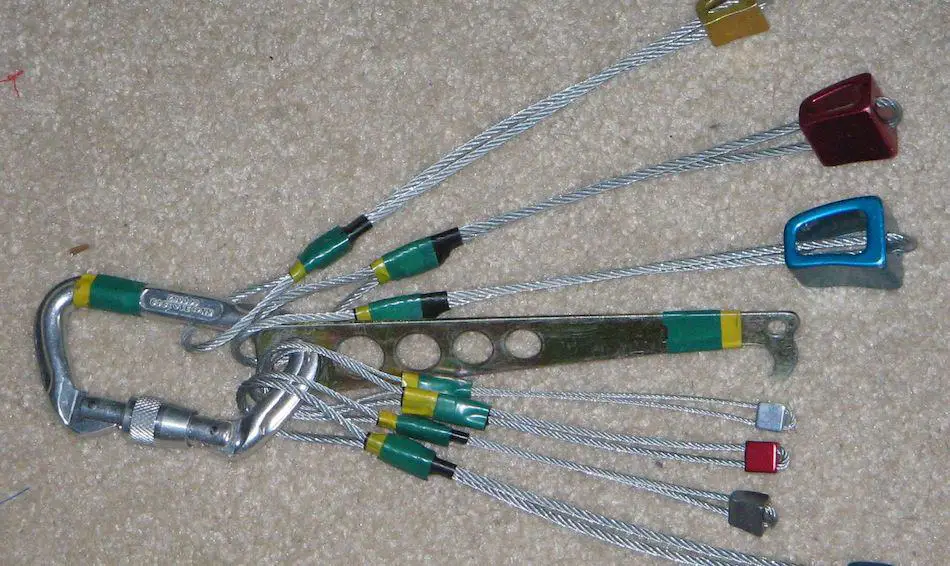
Trad climbing is what we discussed in the above paragraphs. Trad climbers go where there are no bolts drilled into the wall, so they need to do something different to stop from falling.
Trad climbers use pieces of gear called cams and nuts to stop from falling. These devices are wedge-shaped pieces of metal that can be slotted into cracks and jammed in place so they don’t come out when weighted. Climbers then anchor themselves to this gear.
I talked about trad climbing above, so I won’t go into more detail about it here. However, it should be noted that trad climbing has essentially the opposite pros and cons that sport climbing does; it allows you to go more places, but it’s often more dangerous, because gear you place yourself isn’t as secure as gear that’s been drilled into the wall.
Mountain Climbers: By Using Ice Screws and Pitons

On top of using all of the other devices that we already discussed, mountain climbers have some other, more specialized ways of preventing themselves from falling.
Mountain climbers use devices called pitons (long nails they hammer into the rock) and ice screws (devices they twist into ice) to prevent them from falling. These are used along with other devices, like cams and nuts.
Because they often have to content with snow, ice, and long stretches of blank rock, mountain climbers need a few more specialized pieces of gear to prevent them from falling when they’re going for the summit.
Pitons are long, wedge-shaped nails that mountaineers nail into gaps in the rock. They’re permanent fixtures that can’t be removed, which has both pros and cons. The pros are that they’re more solid than cams and nuts, which are designed to be removed. However, the cons are that they damage the rock and leave permanent scars, so typical climbing ethic is to use them as little as possible.
Ice screws are, as the name suggests, long screws that can be twisted into patches of ice (as seen above). Ice screws can be removed and don’t leave permanent scars; however, they’re only as solid as the that they’re in, which can sometimes be questionable. However, a good ice screw will go in eight inches into rock-solid ice, giving a pretty solid catch.
Boulderers: By Using Portable Crash Pads
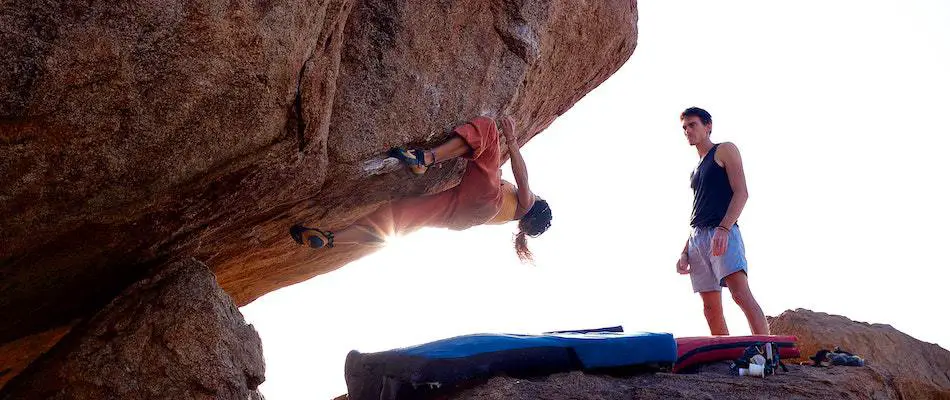
This is a bit of a cheat answer, because this doesn’t so much prevent boulderers from falling as it does break their fall so they don’t get hurt.
Boulderers use folding pads, called ‘crash pads’, to break their fall when they climb. These are four-to-six inch thick foam pads that are placed on the ground beneath the boulderer, cushioning their landing when they do fall.
The whole point of bouldering is that you don’t use a rope when climbing, which means that falling is inevitable. However, that doesn’t mean that climbers are happy landing on the hard ground, which often includes lots of sharp rocks.
Instead, they’re bring a bouldering pad like this, which is basically just a folding mattress that is placed beneath the climber. When the climber falls, they land on top of the mattress instead of the ground, avoiding broken ankles and other injuries.
